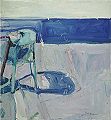
Bay Area Figurative School
Encyclopedia


San Francisco Bay Area
The San Francisco Bay Area, commonly known as the Bay Area, is a populated region that surrounds the San Francisco and San Pablo estuaries in Northern California. The region encompasses metropolitan areas of San Francisco, Oakland, and San Jose, along with smaller urban and rural areas...
who abandoned working in the prevailing style of Abstract Expressionism
Abstract expressionism
Abstract expressionism was an American post–World War II art movement. It was the first specifically American movement to achieve worldwide influence and put New York City at the center of the western art world, a role formerly filled by Paris...
in favor of a return to figuration in painting during the 1950s and onward into the 1960s.
Spanning two decades, this art movement is often broken down into three groups, or generations: the First Generation, the Bridge Generation, and the Second Generation.
Many of the "First Generation" artists in this movement were avid fans of Abstract Expressionism
Abstract expressionism
Abstract expressionism was an American post–World War II art movement. It was the first specifically American movement to achieve worldwide influence and put New York City at the center of the western art world, a role formerly filled by Paris...
, and worked in that manner, until several of them abandoned non-objective painting in favor of working with the figure. Among these First Generation Bay Area Figurative School artists were: David Park, Richard Diebenkorn
Richard Diebenkorn
Richard Diebenkorn was a well-known 20th century American painter. His early work is associated with Abstract expressionism and the Bay Area Figurative Movement of the 1950s and 1960s. His later work were instrumental to his achievement of worldwide acclaim.-Biography:Richard Clifford Diebenkorn Jr...
, Elmer Bischoff
Elmer Bischoff
Elmer Nelson Bischoff was a visual artist in the San Francisco Bay Area.Bischoff, along with Richard Diebenkorn and David Park, was part of the post-World War II generation of artists who started as abstract painters and found their way back to figurative art.-Biography:Elmer Bischoff, second...
, Wayne Thiebaud
Wayne Thiebaud
Wayne Thiebaud is an American painter whose most famous works are of cakes, pastries, boots, toilets, toys and lipsticks. He is associated with the Pop art movement because of his interest in objects of mass culture, although his works, executed during the fifties and sixties, slightly predate...
, and James Weeks.
The "Bridge Generation" included the artists: Nathan Oliveira
Nathan Oliveira
Nathan Oliveira was an American painter, printmaker, and sculptor, born in Oakland, California to Portuguese parents...
, Theophilus Brown
Theophilus Brown
William Theophilus Brown is an American artist born in Moline, Illinois. He became prominent as a member of the Bay Area Figurative Movement.-Background and career:...
, Paul John Wonner, Roland Petersen
Roland Petersen
Roland Petersen is an American painter and printmaker of Danish birth.Petersen was born in Endelave, Denmark in 1926. He studied at University of California at Berkeley, San Francisco Art Institute, California College of Arts and Crafts, Atelier 17 , Islington Studio, London, the Print Workshop,...
, Frank Lobdell.
Many "Second Generation" artists of this movement studied under the First Generation artists, or were late starters. Among these Second Generation artists were: Bruce McGaw, Henry Villierme
Henry Villierme
Henry Pierre Villierme is an American painter associated with abstract expressionism and the Bay Area Figurative Movement. Villierme is considered one of the "Second Generation" members of the Bay Area Figurative Movement. Villierme first rose to prominence with a series of successful exhibitions...
, Joan Brown
Joan Brown
Joan Brown was an American figurative painter who lived and worked in Northern California. She was a notable member of the "second generation" of the Bay Area Figurative Movement....
, and Manuel Neri
Manuel Neri
Manuel Neri is an American sculptor, painter, and printmaker and a notable member of the "second generation" of the Bay Area Figurative Movement.- Biography :...
.
Many San Francisco area schools and institutions were important to the development and refinement of this art movement, including: the San Francisco Art Institute
San Francisco Art Institute
San Francisco Art Institute is a school of higher education in contemporary art with the main campus in the Russian Hill district of San Francisco, California. Its graduate center is in the Dogpatch neighborhood. The private, non-profit institution is accredited by WASC and is a member of the...
, the California College of Arts and Crafts, and University of California, Berkeley
University of California, Berkeley
The University of California, Berkeley , is a teaching and research university established in 1868 and located in Berkeley, California, USA...
.
External links
- "Bay Area Figurative Movements", John Natsoulas Gallery, 2006.
- "The San Francisco Rebellion" by Edward M. Gomez, TimeTime (magazine)Time is an American news magazine. A European edition is published from London. Time Europe covers the Middle East, Africa and, since 2003, Latin America. An Asian edition is based in Hong Kong...
, February 5, 1990. - "Review/Art: San Francisco Revolution in Style Recalled in a Traveling Exhibition" by Roberta Smith, New York Times, August 29, 1990.
- "The Lighter Side of Bay Area Figuration", San Jose Museum of ArtSan Jose Museum of ArtThe San Jose Museum of Art is an art museum in Downtown San Jose, California, USA. Founded in 1969, the museum hosts a large permanent collection emphasizing West Coast artists of the 20th- and 21st-century. It is located next to the Circle of Palms Plaza and Plaza de César Chávez...
, September 3–November 26, 2000.

